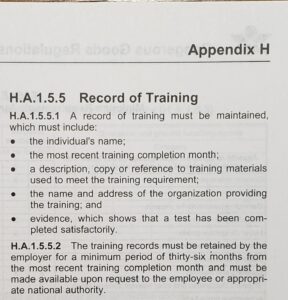Before we begin…
This Q&A is based on the 63rd Edition of the IATA Dangerous Goods Regulations, effective in calendar year 2022.
Sent from the Contact Me page of my website:
Message Body:
I have an on-line shipping training on the IATA Dangerous Goods Regulations for researchers at my institution on shipping biologicals and dry ice by air. A test is given and upon passing they get a certificate with my name and the date on it along with a description of the course: Shipping Dangerous Goods training and Class 6.2 Infectious substances and Class 9 Miscellaneous Goods.
Our parent organization wants to have 1 training for many institutions within the system. Currently the biosafety officers at institutions with biosafety programs have their own programs/tests for this certification. And we are available for consult with any questions. I am not sure that the smaller hospitals that have some shipping needs should be certified by myself or one corporate trainer. I don’t even know where these institutions are located.
The question is, what are the requirements for the actual certificate, (Does the trainer’s name need to be on this?) and does each entity/hospital within the larger corporation need to have a trained trainer on site to cover the needs of these hospitals? Is each individual institution liable for their own shippers?
Thank you for your insight.
|
Daniels Training Services, Inc. 815.821.1550 |
My reply:
Thank you for contacting me. Please see below.
- IATA (the International Air Transport Association) does not require a certificate for trainees upon completion of training. I provide a certificate with my training because people expect it.
- IATA regulations at 1.5.1.4 require the following record of training and assessment (initial and biennial):
- Individual’s name.
- Most recent training and assessment completion month.
- Description, copy, or reference to training materials used.
- Name and address of organization providing training. Not the name of the trainer, though I put mine on it.
- Evidence which shows that personnel have been assessed as competent.
- I created a record of the training separate from the certificate that I use in my training. The record is designed to meet the requirements of 1.5.1.4 described above.
- Beginning with the 62nd Edition, effective from January 01, 2021 to December 31, 2021, the Dangerous Goods Regulations require applicable personnel to be trained as assessed to determine their competence instead of being trained and tested. The requirement for an assessment of competence instead of a test continued with the 63rd Edition in 2022.
- However, the new – and more stringent – requirements do not go become mandatory until 01.01.23. The regulations requiring a test instead of an assessment are found in Appendix H, Attachment A of the IATA Dangerous Goods Regulations and may be used until December 31, 2022.
- Each site does not have to have its own trainer. I provide training for multiple businesses.
- Each employer is required to ensure its personnel receive the required training and are trained or assessed to determine competence.
I hope this helps. Please contact me with any other questions.
Additional concerns:
Thank you. My concern is if there were an incident, we have our training online, and only admins would have access to the exam results which would need to be presented. What is the liability for the “owner” of the training? When there are incidents, who provides the corrective action letter? I’ve done this for my institution.
I appreciate you advice.
My reply:
Good questions. Legitimate concerns. Please see below.
- Any training – at least mine – will provide you with the required record of the training. This may include documents to print or save as pdf.
- The Dangerous Goods Regulations do not require the employer to provide access to the exam results to an inspector or anyone else. H.A 1.5.5.1 of Attachment A of Appendix H requires the record of the training to include: “evidence, which shows that a test has been completed satisfactorily.” While providing access to exam results is one may to meet this requirement, it is not the only way.
- There is no liability for the owner of the training (if by that you mean the training provider). Regulations of IATA & USDOT/PHMSA put the responsibility for ensuring training and testing are adequate on the employer.
- Not quite sure what you mean by “incidents”. If you mean an inspection by a regulatory agency, then the employer must make records of training available for inspection. These records may be a hardcopy or electronic.
- If applicable, a corrective action letter would be written by the company faced with the non-compliance. Likely the employer. However a corrective action letter won’t be necessary if training and assessment (or testing) are adequate and records available for inspection.
Please contact me with any other questions.
That settled it!:
Hi Daniel,
Thank you for your help.
I have another issue, I’d like to run by you.
…but that will have to wait for another Q&A.
|
Contact me with any questions you may have about the transportation of hazardous materials by air, highway, vessel, or rail International and Domestic |
Conclusion:
This person is right to be vigilant about their training records. The best training accomplishes little if an accurate record is not kept demonstrating compliance with the applicable regulations. That’s why I assist my customers until they have completed the recordkeeping for the training I provide them.
